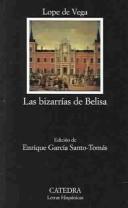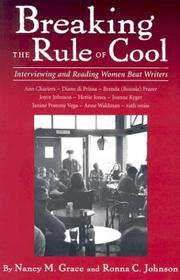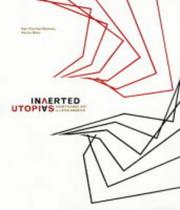| Listing 1 - 6 of 6 |
Sort by
|
Digital
ISBN: 9781846152726 Year: 2004 Publisher: Woodbridge Tamesis
Abstract | Keywords | Export | Availability | Bookmark
 Loading...
Loading...Choose an application
- Reference Manager
- EndNote
- RefWorks (Direct export to RefWorks)
Book
ISBN: 128194985X 9786611949853 1846152720 Year: 2004 Publisher: Woodbridge, Suffolk, UK ; Rochester, NY : Tamesis,
Abstract | Keywords | Export | Availability | Bookmark
 Loading...
Loading...Choose an application
- Reference Manager
- EndNote
- RefWorks (Direct export to RefWorks)
A study of Lope's religious plays and their reflection of the theocentric world of seventeenth-century Spain. Lope de Vega's religious plays are a distinctive part of his output, but little scholarly work is available on them. This study focuses on five plays, La hermosa Ester, the Isidro plays, Lo fingido verdadero and La buena guarda. Within the context of the seventeenth-century stage, Canning examines Lope's manipulation of religious material, and his treatment of socio-literary themes - love, the role of women - and the way in which theyare employed to generate audience reception. She considers the relationship between religious drama and metatheatre, focusing on Lope's techniques for highlighting the illusory nature of life and the relationship between lo verdadero and lo divino, concepts which lie at the heart of the theocentric world view of seventeenth-century Spain. The conflicting imperatives of human and divine love and the issue of identity are features of all of theplays. And she shows that the interplay between illusion and reality and the relationship between playwright and audience are crucial to Lope's dramatic output. ELAINE CANNING lectures in Spanish at the University of Wales, Bangor.
Religious drama, Spanish --- Christian saints in literature. --- History and criticism. --- Vega, Lope de, --- Criticism and interpretation. --- Spanish religious drama --- Spanish drama --- Vega, Lope de Carpio, --- Carpio, Lope Félix de Vega, --- Vega y Carpio, Lope Félix de, --- Vega Karpio, Lope Phelix de, --- Burguillos, Tomé de, --- Vega Carpio, Lope Félix de, --- Karpio, Lope Phelix de Vega, --- De Vega, Lope, --- De Vega Carpio, Lope Félix, --- De Vega y Carpio, Lope Félix, --- De Vega Karpio, Lope Phelix, --- De Burguillos, Tomé, --- De Carpio Vega, Lope, --- Carpio Vega, Lope de, --- Ṿegah, Lopeh deh, --- וגה, לופה דה,

ISBN: 9788437621654 8437621658 Year: 2004 Publisher: Madrid: Cátedra,
Abstract | Keywords | Export | Availability | Bookmark
 Loading...
Loading...Choose an application
- Reference Manager
- EndNote
- RefWorks (Direct export to RefWorks)
Cuando Lope de Vega escribe «Las bizarrías de Belisa» en 1634 tiene a sus espaldas una extraordinaria trayectoria en la que confluye el éxito con la desgracia, la fama con la condena. Lope goza, por un lado, del privilegio de ser un mito canonizado en vida, y por otro, se ve apremiado por numerosos desencantos que vierte en una expresión estética que oscila entre lo realista y lo distorsionado. Sus relaciones con el todo poderoso valido del rey, el Conde Duque de Olivares, son poco armónicas, y su situación anímica fluctúa entre la necesidad de reconocimiento literario y el deseo de evadirse de la Corte. En «Las bizarrías de Belisa» la ciudad de Madrid invade el texto como un marco tan hermoso de día como inhóspito de noche, bullicioso e impredecible, incita una serie de conductas agresivas, desde la inauguración de nuevas respuestas a la violencia simbólica que impone el trazado de calles y edificios. La comedia establece una compleja relación entre comportamiento humano y entorno arquitectónico, muy interesante para el lector moderno.
Article
Abstract | Keywords | Export | Availability | Bookmark
 Loading...
Loading...Choose an application
- Reference Manager
- EndNote
- RefWorks (Direct export to RefWorks)
Crasset, Matali --- Dubbeldam, Winka --- Dune --- Fels, Sarah --- Frattini Magnusson, Emanuela --- Leon Boym, Laurene --- Meyers, Victoria --- Mir, Ana --- Nicoletti, Monica --- Soo, Yeon --- Spear, Laurinda --- Vega, Camila --- Zeisel, Eva

ISBN: 1578066549 1578066530 1604735996 9781604735994 Year: 2004 Publisher: Jackson : University Press of Mississippi,
Abstract | Keywords | Export | Availability | Bookmark
 Loading...
Loading...Choose an application
- Reference Manager
- EndNote
- RefWorks (Direct export to RefWorks)
BIOGRAPHY ̈ LITERARY CRITICISM--> The Beat movement nurtured many female dissidents and artists who contributed to Beat culture and connected the Beats with the second wave of the women's movement. Although they have often been eclipsed by the men of the Beat Generation, the women's contributions to Beat literature are considerable. Covering writers from the beginning of the movement in the 1950's and extending to the present, this book features interviews with nine of the best-known women Beat writers, including Diane di Prima, ruth weiss, Joyce Johnson, Hettie Jones, Joanne Kyger, Brenda Fraz
Beat generation --- Beat movement --- Sociology of literature --- American literature: authors --- American literature --- 20th century --- History and criticism --- Women and literature --- United States --- History --- Women authors --- Authors [American ] --- Interviews --- DiPrima, Diane --- Kyger, Joanne --- Jones, Hettie --- Johnson, Joyce --- Vega, Janine Pommy --- Waldman, Anne --- Charters, Ann --- Frazer, Brenda --- Weiss, Ruth --- Beat generation. --- Authors, American --- Women authors, American --- History and criticism. --- Beatniks --- Persons --- Bohemianism --- English literature --- Agrarians (Group of writers) --- Beats (Persons). --- Beats (Persons)

ISBN: 0300102690 Year: 2004 Publisher: New Haven Yale University Press
Abstract | Keywords | Export | Availability | Bookmark
 Loading...
Loading...Choose an application
- Reference Manager
- EndNote
- RefWorks (Direct export to RefWorks)
Inverted Utopias is the first exhibition in the United States devoted to the brilliant, innovative contributions of Latin American artists to the phenomenon that became the 20th-century avant-garde.The exhibition spans the decades 1920 to 1970, bringing together more than 200 works by 67 artists from Argentina, Brazil, Chile, Colombia, Cuba, Mexico, Puerto Rico, Uruguay, and Venezuela. The presentation integrates outstanding examples of the visual arts (painting, sculpture, assemblage, mixed media, installation, and performance) with printed materials (books, manifestos, and reviews). The works on view are presented in dialogue with two distinctive periods of the 20th century. In the first—comprising the decades 1920 to 1940—artists who were considered the pioneers of the Latin American avant-garde returned from Europe, where they had taken part in cutting-edge movements such as Cubism, Futurism, and Constructivism. Having assimilated these trends into highly innovative ideas that set new standards for artistic creation in Latin America, these forerunners sought to make real the promise of a “new art” for societies undergoing the initial stages of modernization. The second period—the decades 1950 to 1970—witnessed the expansion of avant-garde activities throughout the region as well as the autonomy from contemporary developments in Europe and the United States. The exhibition is organized according to the following six constellations: Universal and Vernacular; Play and Grief; Progression and Rupture; Vibrational and Stationary; Touch and Gaze; and Cryptic and Committed. Universal and Vernacular - This section addresses the paradoxical desire for a type of art rooted in the vernacular, yet imbued with universal appeal. Artists in this constellation—including David Alfaro Siqueiros (1896-1974), Xul Solar (1887-1963), Joaquín Torres-García, Gonzalo Fonseca (1922-1997), Francisco Matto (1911-1995), and Eduardo Abela (1889-1965)—combine the recovery of native, colonial, and folk art elements with the innovative artistic vocabulary of avant-garde movements such as Cubism, Expressionism, and Constructivism. Some of the issues addressed by these artists are the emergence of a New World artistic consciousness, the exaltation of their origins—whether indigenous, mestizo, black, or mulatto—and the attempt to create a universal means of artistic communication out of codified symbols. This constellation will introduce United States audiences to the little known work of the Brazilian Vicente do Rego Monteiro (1899-1970) as well as the Cubans Eduardo Abela and Carlos Enríquez (1900-1957). Play and Grief - Play and Grief brings together artists who reject the formalism of art-for-art´s sake in favor of an open denunciation of social and political injustice. What distinguishes this body of work is its rejection of traditional artistic formats—such as painting and sculpture—in favor of openly unconventional techniques and materials. Works by José Clemente Orozco (1883-1949), Antonio Berni (1905-1981), Jorge de la Vega (1930-1971), Rubén Santantonin (1919-1969), Alberto Heredia (1924-2000), and Carlos Raquel Rivera (born 1923), among others, engage these ideas through parody and allegory, being also irreverent of social conventions and religious myths. Additionally, all of the artists included in this constellation combine traditional artistic genres and stylistic conventions in ways that yield interesting crossings between painting and sculpture, collage and assemblage, everyday objects and fine art. The work of unabashedly critical women artists such as Débora Arango (born 1910)—whose work is being shown for the first time in the United States—and Beatriz González (born 1938) is noteworthy for its early incrimination of violence (Arango) and its outright mockery of artistic genres (González). Progression and Rupture - Artists from the Southern Cone region (Chile, Argentina, Uruguay, Southern Brazil) who engaged early on in geometric abstraction and constructivism are featured in this constellation. The utopian dimension of these works is centered on the universal appeal of such notions as structure, order, synthesis, and a will for totality. The attempt to imbue geometry with a vital dimension that incorporates the viewer´s active participation of the work was a distinguishing feature of these artists´ approach that both confronts and extends the legacy of Constructivism into an unexplored dimension. Proceeding from the pioneering work of Joaquín Torres-García and Lucio Fontana (1899-1968), the selection highlights the paradigmatic role played by the artist-theoreticians of the Argentinean Madí movement [Gyula Kosice (born 1924), Rhod Rothfuss (1920-1969) and Carmelo Arden Quin (born 1913)], as well as the Brazilian ruptura [Waldemar Cordeiro (1925-1973), Luis Sacilotto (1923-2003)] and Neo-concrete groups [Hélio Oiticica (1937-1980), Lygia Clark (1920-1988), Willys de Castro (1926-1988), Hércules Barsotti (born 1914)]. Vibrational and Stationary - The attempt to resolve the dilemma between movement and stasis that characterized Western art from its inception is the topic of this constellation that brings together artists working toward the utopian goal of producing an art of pure movement. Artists as disparate as David Alfaro Siqueiros, Antonio Berni, Jesús Rafael Soto (born 1923), Alejandro Otero (1921-1990) and Carlos Cruz-Diez (born 1923) engaged the complex legacies of Futurism and Constructivism and updated other dynamic and kinetic trends from a New World perspective. The originality of their achievements range from Siqueiros´ cinematographic murals, to the serial progressions of Soto, the methodical rhythmicolors of Otero, and the physichromatic vibrations of Cruz-Diez. Gego (1912-1994) is shown for the first time in this context as a critical counterpoint of the well-known narrative of Venezuelan Cinetismo. Touch and Gaze - The utopia of a unique art grounded in the combined sensorial experiences of vision and touch interrelates this constellation. Each of the works gathered here illuminates both the optical and the tactile dimensions of human experience. This comparative ensemble ranges from the de-materialized perception of light evident in Armando Reverón´s (1889-1954) white paintings, to the sensorial synthesis of Soto, Lucio Fontana, and Sérgio Camargo (1930-1990), Gego´s spatialized drawing, Lygia Clark´s and Hélio Oiticica´s "haptic gaze", passing through the mobile optics of Julio Le Parc (born 1928), the light-and-water experiences of Gyula Kosice, and culminating in the sensuous color-bath of Cruz-Diez´s chromosaturations. Cryptic and Committed -Artists working in the politically repressive countries of Brazil, Argentina, Uruguay, and Chile in the 1960s and 1970s devised highly original conceptual strategies in response to the authoritarian climate of the time. In fact, the practices of artists such as Cildo Meireles (born 1948), Oiticica and Clark, Alberto Greco, León Ferrari, Arte de los Medios, and the Tucumán Arde collective constitute one of the most outstanding chapters of the avant-garde in Latin America. In the last decade, the significance of their contribution has attracted the attention of art historians and critics from all over the world.
avant-garde --- Art --- Latin America --- Art, Latin American --- Avant-garde (Aesthetics) --- History --- Latin American --- Xul Solar, Alejandro --- Reverón, Armando --- Orozco, José Clemente --- Siqueiros, David Alfaro --- Gego --- Oiticica, Hélio --- Abela, Eduardo --- Arango, Débora --- Arden Quin, Carmelo --- Barsotti, Hércules --- Fontana, Lucio --- Cordeiro, Waldemar --- Castro, de, Willys --- González, Beatriz --- Rothfuss, Rhod --- Sacilotto, Luiz --- Santantonin, Rubén --- Monteiro, Vicente do Rêgo --- Torres García, Joaquín --- Cruz-Diez, Carlos --- Parc, le, Julio --- Soto, Jesús Rafael --- Meireles, Cildo --- Clark, Lygia --- Rivera, Carlos Raquel --- Berni, Antonio --- Camargo --- Fonseca, Gonzalo --- Heredia, Alberto --- Kosice, Gyula --- Matto, Francisco --- Otero, Alejandro --- Vega, de la, Jorge --- anno 1900-1999 --- Cuba --- Puerto Rico --- Mexico --- Brazil --- Argentina --- Chile --- Colombia --- Venezuela --- Uruguay
| Listing 1 - 6 of 6 |
Sort by
|

 Search
Search Feedback
Feedback About
About Help
Help News
News